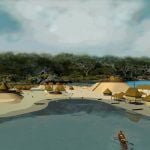
About twenty miles north of Mobile, the Tensaw separates from the Mobile river, running to the east by a very tortuous course as far as Stockton, then to the south, emptying into the east side of Mobile bay. Between these two rivers is enclosed a tract of land, twenty miles long and about seven wide, consisting of marsh and swamp land. Much of it is impassable; some of it quakes and sinks beneath the tread, and is covered with tall grass and aquatic plants; the larger portion supports heavy forests, and is called swamp land. Only small portions of the whole tract are dry even in dry weather, or elevated above the spring floods. North of the Tensaw, land of a similar character extends for ten miles. The tract between the two rivers is intersected by several creeks and rivers; Middle river, which is wide and deep, flows out of the Tensaw soon after the latter leaves the Mobile, and running southeast, empties again into the Tensaw; thus cutting off a triangular portion from the northeast corner of the tract. Again, Bottle creek leaves the Tensaw not far to the east of Middle river, and running south or west of south, empties into Middle river. In this latter triangular piece, are the mounds. This area is also intersected by the Dominique creek, which runs near to the west side of the mound field, and with which the mounds are connected by a series of small mounds now concealed by the forest. Along with these creeks and rivers are numerous lakes or lagoons, which are affected by the tides, and contain an abundance of fish; indeed the waters teem with them, to an extent which surprises one accustomed to throw the line in clearer streams. Among the inhabitants of these waters, the alligator is not the least abundant, and in a young state, it is yet used occasionally for food, as it appears to have been by the former dwellers upon these banks.

On the west side of Bottle creek, where it leaves the Tensaw, is probably the most elevated portion of the land above described. Here the first inhabitants found sufficient room and material to construct these mounds; and the French a plantation ready for seed. This locality was early settled, and has been cultivated ever since, receiving from the yearly overflow an addition to its fertility. The Gnathodon beds described by Rev. S. C. Hale in this Journal for March, 1851, occur frequently around the head of the bay, but none on Bottle creek; and indeed the Gnathodon shell is but sparsely intermixed in any of the mounds. As low down as within ten miles of the bay. There are mounds raised on the banks of existing creeks and near the beds of former ones, with few shells intermixed with the earth. In such cases they look like small -portions of levees, elevated just above the high floods. They contain no perceptible relics of former life; and appear to me to have been thrown up, as places of security against high water, by some former people, if not for constant use, at least for a summer residence, for the convenience of obtaining food. To a people unaccustomed or unwilling to till the soil, there existed an unfailing source of food, of a kind which is even now much used by the Creoles and negroes living there. The abundance of food and the facility of obtaining it, the convenience of communication by the various creeks, isolation from disturbing tribes, healthiness of the locality,—for the French even went from Mobile to their swamp plantations in summer,—and the mildness of the winter, would induce a tribe to make this region their permanent abode. There is nothing to disprove such a supposition, except the danger and inconvenience of the floods. Against these the mounds are a security; and, in one case a raised ridge is now used as the site of some buildings. On the Gnathodon beds and the mounds hereafter to be described, relics were often found, the most important of which are images. One bust of a person was discovered near the bay, which very strikingly exhibits the Indian features, and also considerable skill on the part of the sculptor; for these images appear to have been first moulded, and then cut out by some edged instrument.

Along the Alabama Gulf Coast the Pensacola culture is known as a variant of the Mississippian culture. Bottle Creek Mounds and the community it was, probably played a central role in this culture since it is the largest Mississippian site in the area. Bottle Creek was occupied primarily between AD 1250 and 1550. It probably served as the principal center for the region during these three centuries, in terms of politics, religion and trade. There is some evidence of earlier occupation and Native Americans continued to occupy the site well into the eighteenth century. The site also experienced considerable settlement and use in the nineteenth and twentieth centuries.
Because of its physical location, little is known about the history and culture of its occupants, despite the fact that it has been in the historical literature for three centuries. In 1995, Bottle Creek became a National Historic Landmark.
